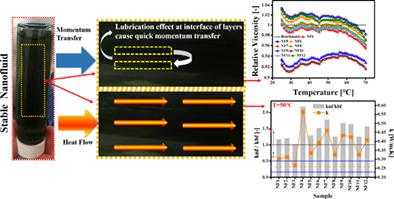当前位置:
X-MOL 学术
›
Int. J. Energy Res.
›
论文详情
Our official English website, www.x-mol.net, welcomes your feedback! (Note: you will need to create a separate account there.)
Thermal conductivity, rheology and stability analysis of 2D tungsten disulphide‐doped polyaniline‐based nanofluids: An experimental investigation
International Journal of Energy Research ( IF 4.6 ) Pub Date : 2020-09-14 , DOI: 10.1002/er.5697 Syed Nadeem Abbas Shah 1, 2 , Syed Shahabuddin 3 , Mohd Faizul Mohd Sabri 1 , Mohd Faiz Mohd Salleh 4 , Suhana Mohd Said 4 , Khaled Mohamed Khedher 5, 6
International Journal of Energy Research ( IF 4.6 ) Pub Date : 2020-09-14 , DOI: 10.1002/er.5697 Syed Nadeem Abbas Shah 1, 2 , Syed Shahabuddin 3 , Mohd Faizul Mohd Sabri 1 , Mohd Faiz Mohd Salleh 4 , Suhana Mohd Said 4 , Khaled Mohamed Khedher 5, 6
Affiliation

|
In this study, polyaniline (PANI) nanocomposite‐based nanofluids (NFs) in ethylene glycol were obtained with a two‐step method by varying volume concentrations from 0.005% to 0.02%. Tungsten disulphide (WS2) nanoparticles were doped in PANI having different weight percentage (1%, 2% and 5%) via oxidative in situ polymerization employing ammonium persulphate oxidant in an acidic environment. The nanocomposites were comprehensively characterised using various techniques, such as Fourier transform infrared spectroscopy, thermogravimetric analysis, field emission scanning electron microscopy and high‐resolution transmission electron microscopy. The formulated NFs were extensively investigated with zeta‐sizer, particle size analyzer, thermal property analyzer and rheometer in a temperature range of 25°C to 70°C. The zeta potential results (up to 54.5 mV) were evident of extraordinary stability of NFs at all targeted temperatures along with polydispersity index <30% and mean particle/agglomerate size in the range of 335.8 to 489 nm. Additionally, a remarkable thermal conductivity improvement (~20.7%) was achieved with intrinsic PANI‐based NFs at an operating temperature of 50°C. Subsequently, it varied substantially with WS2 doping within PANI matrix and reached to 117.9%. Furthermore, the rheological measurements have revealed the viscoelastic nature of NFs along with a remarkable reduction in apparent viscosity (up to 8.4%). The temperature sweep viscosity indicated the transition of relative viscosity from high to low at a critical temperature of about 55°C. The NF10 (WS2 + PANI 5, at 0.005 vol%) was found to be the best candidate with 63.8% thermal conductivity enhancement and 6.4% viscosity reduction as compared with the base fluid at an operating temperature of 50°C. Thus, WS2 doping within PANI has proved to be crucial in the proliferation of thermal conductivity and mitigation of viscosity.
中文翻译:

掺杂二硫化钨的聚苯胺纳米流体的热导率,流变学和稳定性分析:一项实验研究
在这项研究中,乙二醇的聚苯胺(PANI)纳米复合纳米流体(NFs)是通过两步法通过从0.005%到0.02%的体积浓度变化而获得的。二硫化钨(WS 2通过在酸性环境中使用过硫酸铵氧化剂的氧化原位聚合,将纳米颗粒掺杂在具有不同重量百分比(1%,2%和5%)的PANI中。使用多种技术对纳米复合材料进行了全面表征,例如傅立叶变换红外光谱,热重分析,场发射扫描电子显微镜和高分辨率透射电子显微镜。在25°C至70°C的温度范围内,使用zeta-izer,粒度分析仪,热性能分析仪和流变仪对配制的NF进行了广泛的研究。zeta电位结果(高达54.5 mV)证明了NFs在所有目标温度下均具有出色的稳定性,多分散指数<30%,平均颗粒/团聚体尺寸在335.8至489 nm之间。另外,在50°C的工作温度下,使用基于PANI的固有NF可以显着提高导热率(〜20.7%)。随后,随着WS的变化而变化很大在PANI基质中有2种掺杂,达到117.9%。此外,流变学测量已揭示出NF的粘弹性,同时表观粘度也显着降低(最高8.4%)。温度扫描粘度表明在约55℃的临界温度下相对粘度从高到低的转变。 与在50°C的工作温度下的基础流体相比,发现NF10(WS 2 + PANI 5,0.005体积%)是最佳的选择,具有63.8%的导热系数提高和6.4%的粘度降低。因此,事实证明,PANI中的WS 2掺杂对于导热系数的增加和粘度的降低至关重要。
更新日期:2020-09-14
中文翻译:

掺杂二硫化钨的聚苯胺纳米流体的热导率,流变学和稳定性分析:一项实验研究
在这项研究中,乙二醇的聚苯胺(PANI)纳米复合纳米流体(NFs)是通过两步法通过从0.005%到0.02%的体积浓度变化而获得的。二硫化钨(WS 2通过在酸性环境中使用过硫酸铵氧化剂的氧化原位聚合,将纳米颗粒掺杂在具有不同重量百分比(1%,2%和5%)的PANI中。使用多种技术对纳米复合材料进行了全面表征,例如傅立叶变换红外光谱,热重分析,场发射扫描电子显微镜和高分辨率透射电子显微镜。在25°C至70°C的温度范围内,使用zeta-izer,粒度分析仪,热性能分析仪和流变仪对配制的NF进行了广泛的研究。zeta电位结果(高达54.5 mV)证明了NFs在所有目标温度下均具有出色的稳定性,多分散指数<30%,平均颗粒/团聚体尺寸在335.8至489 nm之间。另外,在50°C的工作温度下,使用基于PANI的固有NF可以显着提高导热率(〜20.7%)。随后,随着WS的变化而变化很大在PANI基质中有2种掺杂,达到117.9%。此外,流变学测量已揭示出NF的粘弹性,同时表观粘度也显着降低(最高8.4%)。温度扫描粘度表明在约55℃的临界温度下相对粘度从高到低的转变。 与在50°C的工作温度下的基础流体相比,发现NF10(WS 2 + PANI 5,0.005体积%)是最佳的选择,具有63.8%的导热系数提高和6.4%的粘度降低。因此,事实证明,PANI中的WS 2掺杂对于导热系数的增加和粘度的降低至关重要。


























 京公网安备 11010802027423号
京公网安备 11010802027423号